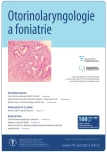-
Medical journals
- Career
Congenital malformations of the inner ear
Authors: S. Šikolová 1; Milan Urík 1; J. Jančíková 1; D. Hošnová 1; R. Katra 2
Authors‘ workplace: Klinika dětské otorinolaryngologie LF MU a FN Brno 1; Klinika ušní, nosní a krční 2. LF UK a FN v Motole, Praha 2
Published in: Otorinolaryngol Foniatr, 70, 2021, No. 3, pp. 167-173.
Category: Review Article
doi: https://doi.org/10.48095/ccorl2021167Overview
Congenital malformations of the inner ear consist of many different anomalies of the labyrinth. They often cause hearing loss, mostly of the sensorineural type. Eighty percent of hearing loss is caused by an anomaly of the membranous labyrinth, and 20% by an anomaly of the bone labyrinth. The role in pathogenesis is played by hereditary factors and influence of the environment. The treatment depends on the severity of the hearing loss, abnormalities of the external and middle ear, associated defects, and presence and function of the auditory nerve. We have modern hearing aids or implantable systems. Another options include a sign language and mouth-reading. The article includes a retrospective analysis of patients with congenital inner ear malformations at our tertiary center in 2010–2020. In conclusion, our patients clearly prove that even children with profound hearing loss are successfully implanted and restored hearing can be achieved in most of them.
Keywords:
congenital ear malformation – inner ear – hearing loss – anomalies of bony labyrinth – anomalies of membranous labyrinth – rehabilitation
Sources
1. Jakubíková J. Vrozené anomálie hlavy a krku. Praha: Grada; 2012.
2. Rodriguez K, Shah RK, Kenna M. Anomalies of the middle and inner ear. Otolaryngol Clin North Am 2007; 40 (1): 81–96, vi. Doi: 10.1016/j.otc.2006.10.006.
3. Yiin RS, Tang PH, Tan TY. Review of congenital inner ear abnormalities on CT temporal bone. Br J Radiol 2011; 84 (1005): 859–863. Doi: 10.1259/bjr/18998800.
4. Anson BJ, Davies J. Embryology of the ear: developmental anatomy of the ear. In: Otolaryngology. 2nd ed. Edited by Paparella MM, Shumrick DA. Philadelphia: WB Saunders 1980 : 3–25.
5. Peck JE. Development of hearing. Part II. Embryology. J Am Acad Audiol 1994; 5 (6): 359–365.
6. Jackler RK, Luxford WM, House WF. Congenital malformations of the inner ear: a classification based on embryogenesis. Laryngoscope 1987; 97 (3 Pt 2 Suppl 40): 2–14. Doi: 10.1002/lary.5540971301.
7. Sennaroglu L, Saatci I. A new classification for cochleovestibular malformations. Laryngoscope 2002; 112 (12): 2230–2241. Doi: 10.1097/00005537-200212000-00019.
8. Sennaroglu L, Sennaroglu G, Atay G. Auditory brainstem implantation in children. Curr Otorhinolaryngol Rep 2013; 1 (2): 80–91. Doi: 10.1007/s40136-013-0016-7.
9. Arellano B, Ramirez-Camacho R, Trinidad A et al. Inner ear malformations: Mondini‘s dysplasia. ORL J Otorhinolaryngol Relat Spec 1999; 61 (6): 360–363. Doi: 10.1159/000027700.
10. Ramírez LV, Cano HD, Lubinus FG. Congenital malformations of the inner ear. Rev Colomb Radiol 2018; 29 (3): 4481–4485.
11. McElveen JT, Jr., Carrasco VN, Miyamoto RT et al. Cochlear implantation in common cavity malformations using a transmastoid labyrinthotomy approach. Laryngoscope 1997; 107 (8): 1032–1036. Doi: 10.1097/00005537-199708000 - 00005.
12. Zhang L, Qiu J, Qin F et al. Cochlear implantation outcomes in children with common cavity deformity; a retrospective study. J Otol 2017; 12 (3): 138–142. Doi: 10.1016/j.joto.2017.03. 004.
13. Urík M, Šlapák I, Hošnová D et al. Bilateral cochlear implantation in children with common cavity. Acta Oto-Laryngologica Case Reports 2020; 5 (1): 38–41. Doi: 10.1080/23772484. 2020.1756820.
14. Pyle GM. Embryological development and large vestibular aqueduct syndrome. Laryngoscope 2000; 110 (11): 1837–1842. Doi: 10.1097/00005537-200011000-00014.
15. Wetmore RF, Muntz HR, McGill TJ. Pediatric Otolaryngology: Principles and Practise Pathways. Stuttgart: Thieme 2000.
16. Yan F, Li J, Xian J et al. The cochlear nerve canal and internal auditory canal in children with normal cochlea but cochlear nerve deficiency. Acta Radiol 2013; 54 (3): 292–298. Doi: 10.1258/ar.2012.110596.
17. Kumakawa K, Takahashi M, Takeda H. Is a narrow internal auditory meatus a contraindication to cochlear implants? Cochlear Implants Int 2004; 5 (Suppl 1): 80–82. Doi: 10.1179/cim. 2004.5.Supplement-1.80.
18. Šlapák I, Urík M. Dětská otorinolaryngologie. Praha: Mladá Fronta 2019.
19. Katra R, Pourová R, Dytrych P. Pendredův syndrm v České republice. Otorinolaryngol Foniatr 2011; 60 (2): 103–111.
20. Blake KD, Prasad C. CHARGE syndrome. Orphanet J Rare Dis 2006; 1 : 34. Doi: 10.1186/ 1750-1172-1-34.
21. Moller CG, Kimberling WJ, Davenport SL et al. Usher syndrome: an otoneurologic study. Laryngoscope 1989; 99 (1): 73–79. Doi: 10.1288/ 00005537-198901000-00014.
Labels
Audiology Paediatric ENT ENT (Otorhinolaryngology)
Article was published inOtorhinolaryngology and Phoniatrics

2021 Issue 3-
All articles in this issue
- The professional journal Otorhinolaryngology and Phoniatrics celebrates 70 years
- Acute vertigo in the ENT emergency
- Evaluation of speech in patients after cochlear implantation – Motol Speech Scale
- Congenital malformations of the inner ear
- Gastric choristoma of hypopharynx in neonate
- Erdheim-Chester disease – case report
- Ultrasound-guided percutaneous ethanol injection therapy of neck cysts as an alternative to surgery
- Komentář ke článku „Hodnocení řeči u pacientů po kochleární implantaci – Motol Speech Scale“
- Odpověď autorů na komentář ke článku „Hodnocení řeči u pacientů po kochleární implantaci – Motol Speech Scale“
- Odešel prim. MUDr. Jiří Sušický
- Vzpomínka na MUDr. Luďka Šefce
- Vzpomínka na doc. MUDr. Miloslava Hroboně, CSc.
- Multiple sclerosis in the otoneurology outpatient clinic: interdisciplinary cooperation between otoneurologist and neurologist
- Otorhinolaryngology and Phoniatrics
- Journal archive
- Current issue
- Online only
- About the journal
Most read in this issue- Congenital malformations of the inner ear
- Acute vertigo in the ENT emergency
- Ultrasound-guided percutaneous ethanol injection therapy of neck cysts as an alternative to surgery
- Evaluation of speech in patients after cochlear implantation – Motol Speech Scale
Login#ADS_BOTTOM_SCRIPTS#Forgotten passwordEnter the email address that you registered with. We will send you instructions on how to set a new password.
- Career

